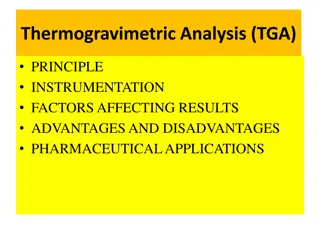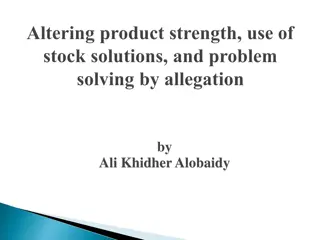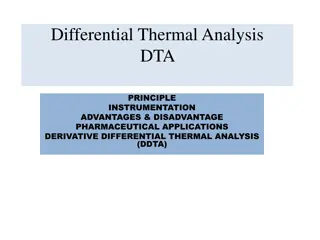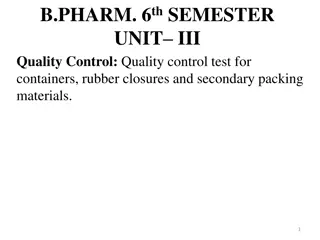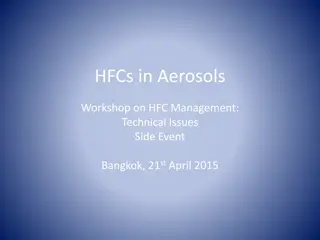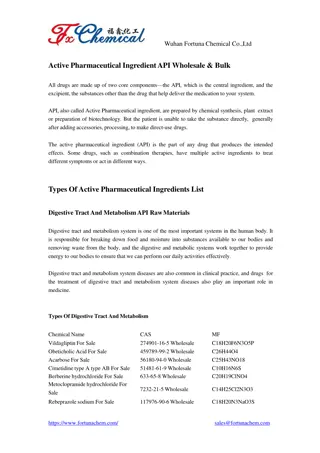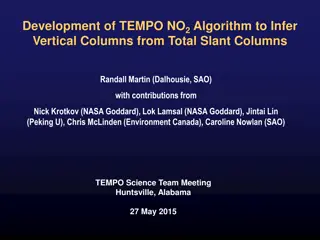Understanding Pharmaceutical Aerosols: Components and Advantages
Pharmaceutical aerosols are pressurized systems used for delivering therapeutic active ingredients. They consist of components like propellants, containers, valves, and product concentrate. The use of aerosols offers advantages such as targeted delivery, reduced irritation, and ease of application. Understanding the physiochemical properties of propellants is crucial for successful aerosol formulation. Proper selection and understanding of components such as valves are essential for effective medication delivery.
Download Presentation

Please find below an Image/Link to download the presentation.
The content on the website is provided AS IS for your information and personal use only. It may not be sold, licensed, or shared on other websites without obtaining consent from the author. Download presentation by click this link. If you encounter any issues during the download, it is possible that the publisher has removed the file from their server.
E N D
Presentation Transcript
PHARMACEUTICAL AEROSOLs Prof. G. B. Patil HRPIPER, Shirpur
Definition Definition Packaging ingredients in a pressurized system. of therapeutic active Aerosols are depends on the power of compressed or liquefied gas to expel the contents from containers.
Advantages Advantages A dose can be removed with out contamination of materials. The medication can be delivered directly to the affected area in a desired form, such as spray, steam, quick breaking foam or stable foam. Irritation produced by the mechanical application of topical medication is reduced or eliminated. Ease of convenience of application. Application of medication in thin layer
Components of aerosols Propellant Container Valve & actuator Product concentrate
Propellant It is responsible for developing the power pressure with in the container and also expel the product when the valve is opened and in the atomization or foam production of the product. For oral and inhalation eg. Fluorinated hydrocarbons Dichlorodifluromethane (propellant 12) Dichlorotetrafluromethane (propellant 114) Topical preparation Propane Butane Isobutane Compound gases Nitrogen Carbon di oxide Nitrous oxide
Containers They must be stand at pressure as high as 140 to 180 psig (pounds per sq. inch gauge) at 1300 F. A. Metals 1. Tinplated steel (a) Side-seam (three pieces) (b) Two-piece or drawn (c) Tin free steel 2. Aluminium (a) Two-piece (b) One-piece (extruded or drawn) 3. Stainless steel B. Glass 1. Uncoated glass 2. Plastic coated glass
Physiochemical properties of propellants Vapor pressure Boiling points Liquid density
Valves To delivered the drug in desired form. To give proper amount of medication. Not differ from valve to valve of medication in pharmaceutical preparation. Types - Continuous spray valve - High speed production technique. - Metering valves Dispersing of potent medication at proper dispersion/ spray approximately 50 to 150 mg 10 % of liquid materials at one time use of same valve.
Valve components Ferrule or mount cap Valve body or housing Stem Gasket Spring Dip tube
Actuator To ensure that aerosol product is delivered in the proper and desired form. Different types of actuators Spray actuators Foam actuators Solid steam actuators Special actuators
Formulation of pharmaceutical aerosols Contains two essential components Product concentrate Propellant Product concentrate Product concentrate contains ingredients or mixture of active ingredients and other such as solvents, antioxidants and surfactants. Propellant May be single or blend of various propellants Blends of propellant used in a p ceutical formulation to achieve desired solubility characteristics or various surfactants are mixed to give the proper HLB value for emulsion system. To give the desired vapor pressure, solubility & particle size.
Parameters consideration Physical, chemical and p ceutical properties of active ingredients. Site of application
Types of system Solution system Water based system Suspension or Dispersion systems Foam systems 1. Aqueous stable foams 2. Nonaqueous stable foams 3. Quick-breaking foams 4. Thermal foams Intranasal aerosols
Manufacturing Aerosols of Pharmaceutical Apparatus Pressure filling apparatus Cold filling apparatus Compressed gas filling apparatus
Quality control for pharmaceutical aerosols Propellants Valves, actuator and dip tubes Testing procedure Valve acceptance Containers Weight checking Leak testing Spray testing
Evaluation parameters of pharmaceutical aerosols A. Flammability and combustibility 1. Flash point 2. Flame extension, including flashback B. Physiochemical characteristics 1. Density 2. Moisture content 3. Identification of propellant(s) 4. Concentrate-propellant ratio 5. Vapor pressure C. Performance 1. Spray pattern 2. Aerosol valve discharge rate 3. Dosage with metered valves 4. Net contents 5. Foam stability 6. Particle size determination 7. Leakage D. Biologic characteristics E. Therapeutic activity
Flame Projection This test indicates the effect of an aerosol formulation on the extension of an open flame. Product is sprayed for 4 sec. into flame. Depending on the nature of formulation, the fame is extended, and exact length was measured with ruler.
Flash point Determined by using standard Tag Open Cap Apparatus. Step involves are Aerosol product is chilled to temperature of - 25 0 F and transferred to the test apparatus. Temperature of test liquid increased slowly, and the temperature at which the vapors ignite is taken a flash point. Calculated for flammable component, which in case of topical hydrocarbons.
Vapor pressure Determined by pressure gauge Variation in pressure indicates the presence of air in headspace. A can punctuating device is available for accurately measuring vapor pressure.
Density Determined by hydrometer or a pycnometer. Step involves are A pressure tube is fitted with metal fingers and hoke valve, which allow for the introduction of liquids under pressure. The hydrometer is placed in to the glass pressure tube. Sufficient sample is introduced through the valve to cause the hydrometer to rise half way up the length of the tube. The density can be read directly.
Moisture content Method used -- Karl Fischer method G. C has also been used Identification of propellants G.C, I.R Spectrophotometry Aerosol valve discharge rate Determined by taking an aerosol known weight and discharging the contents for given time using standard apparatus. By reweighing the container after time limit has expired, the change in weight per time dispensed is discharge rate, Expressed as gram per seconds.
Dosage with metered valves Amt. of medication actually received by the patient. Reproducibility has been determined by assay technique, Another method is that, involves accurate weighing of filled container fallowed by dispersing of several doses, container can reweighed, and difference in weight divided by No. of dose, gives the average dosage. Reproducibility of dosage each time the valve is dispersed
Net contents Weight method Filled full container, and dispensing the contents Foam stability Visual evaluation Time for a given mass to penetrate the foam Times for given rod that is inserted into the foam to fall The use of rotational viscometers
Particle size determination Cascade impactor Cascade impactor Light scatter decay method Cascade impactor Operates on the projected through a series of nozzle and glass slides at high viscosity, the large particles become impacted first on the lower velocity stages, and the smaller particles pass on and are collected at high velocity stages. These particles ranging from 0.1 to 30 micron and retaining on RTI. Modification made to improve efficacy
Light Scattering method Porush, Thiel and Young used light scattering method to determine particle size. As aerosols settle in turbulent condition , the change in light intensity of Tyndall beam is measured Sciarra and Cutie developed method based on practical size distribution.
Metered dose inhaler To increased interest in modifying metered dose inhalers (MDIs) to minimize the number of Administration error and to improve the drug delivery of aerosols particles into the drug delivery system of the nasal passageways and respiratory tract.
Dry Powder Inhalers (DPIs) Drug is inhaled as a cloud of fine particles. The drug is either preloaded in an inhalation device or filled into hard gelatin capsule or foil blister discs which are loaded in to a device prior to use. Dry powder inhalers are devices through which dry powder formulation of an active drug is delivered for local or systemic action via pulmonary route. They are bolus drug delivery systems that contain solid drug substance that is suspended or dissolved in a non-polar propellant that is fluidized when the patient inhales.
Ideal DPI Effective dosing Uniform dose Targeted delivery Operable at low inhalation flow rates Efficient device Easy to use
FORMULATION DPI formulations are generally engineered composites, containing a drug material of micron size formulated with or without a large carrier material. The formulation is formulated around a device that when actuated by patient is capable of producing a respirable aerosol cloud that penetrates the respiratory tract and reaches the site of action.
STEPS INVOLVED IN FORMULATION Active Pharmaceutical Ingredient (API) production. Formulation of API with or without carriers. Integration of the formulation into device.
DPI Design Issues Inhaler design, especially the geometry of the mouth piece, is critical for patients to produce an air flow sufficient to lift the drug from the dose chamber, break up the agglomerates in the turbulent air stream and deliver the drug dose to the lungs as therapeutically effective fine particles.
Principle of operation When the patient actuates the DPI and inhales, airflow though the device creates shear and turbulence; air is introduced in to the powder bed and the static powder blend is fluidized and enters the patient airways. There the drug particles separate from the carrier particles and are carried deep into the lungs to exert the effects.
Evaluation Appearance Identity Microbial limits Water content Extractives Drug related impurities Particle analysis Drug content per unit dose/dose delivery
Advantages Propellant free design Less need for patient coordination Less potential for formulation problems Environmental sustainability Less potential for extractable from device components
Disadvantages Dependency on patient inspiration flow rate and profile Device resistance and other device issues More expensive than pressurized MDI Complex development and manufacture Not available world wide Greater potential problems in dose uniformity
THANK YOU Prof. Ganesh B. Patil gbp84@rediffmail.com







